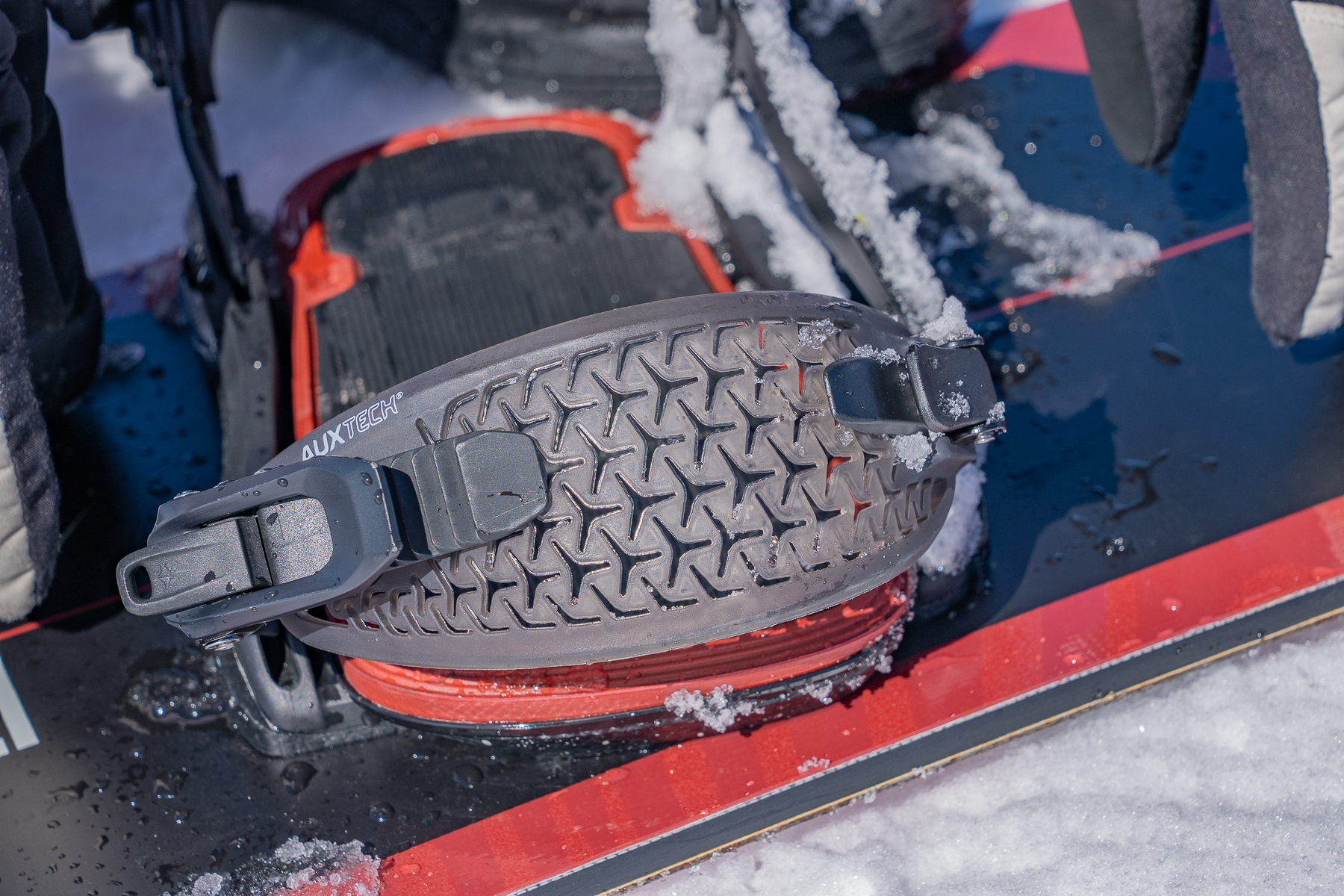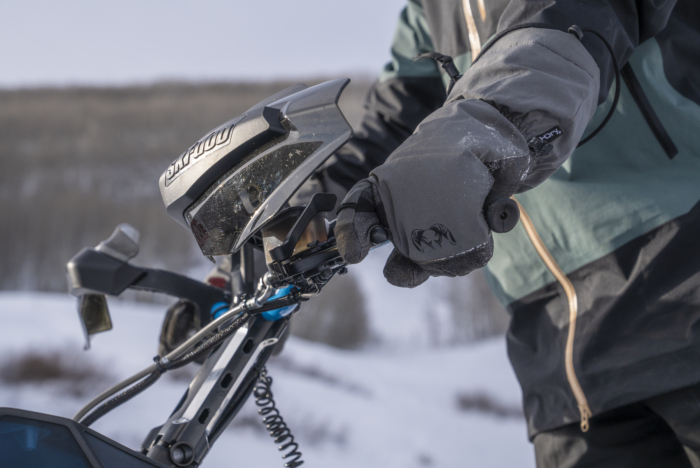Snowboard bindings are your point of contact with your snowboard — as a joint, they change how you connect with your gear and with the ground.
Bindings come in a variety of flex, shape, and construction from rigid freeride and big-mountain bindings to flexible park bindings, with a few different entry and exit styles. If you’re looking for a comfortable, malleable, all-around pair go for the Rome Women’s Katana and Rome Men’s Katana Pro. If you prefer a stiffer build, you might prefer the support of the Union Legacy.
Here are our picks for the best snowboard bindings of the year, from the park to freeride to the backcountry.
Editor’s Note: We updated our Snowboard Bindings buyer’s guide on November 13, 2024, with the Union Legacy Women’s Snowboard Bindings, Yes Conda, Rome Women’s Katana, and Rome Men’s Katana Pro.
The Best Snowboard Bindings of 2025
Top Picks
- Style: Strap-in
- Flex: Medium-to-firm
Pros
- Lightweight thanks to infused Carbon
- Adjustability for perfect fitment
Cons
- Price



- Style: Strap-in
- Flex: Medium
Pros
- Extremely comfortable with zero pressure points
- Easy-release toe and ankle straps fit flush around boot
- Lightweight
- Well built and durable
Cons
- Pricier choice
- Not the stiffest select if that’s your priority



- Style: Strap-in
- Flex: Medium/Soft
Pros
- Lightweight
- Price
Cons
- Soft feel is less responsive on steep and icy slopes
- Style: Rear-entry step-in
- Flex: Medium
Pros
- Price
- Quick boot entry
Cons
- Takes some tweaking to get the straps set up initially
- Style: Strap-in
- Flex: Medium/Rigid
Pros
- Versatile
- Comfortable
- Responsive in any terrain
Cons
- If you want a soft pair, look at other options
- Style: Strap-in
- Flex: Moderately Stiff
Pros
- Light and lean
- Lateral flex
- Longitudinal stiffness
- Stiffer than soft, if you dig that
Cons
- Some riders might prefer a softer, more forgiving design
- Style: Strap-in
- Flex: Moderate
Pros
- Tenacious
- Perfectly flush fit
- Supportive, comfortable highback
- Easy-to-lift baseplate cushion and simple strap adjustment
Cons
- New riders might prefer a softer binding
- Some like an even stiffer saddle
- Style: Step-on
- Flex: Medium
Pros
- Quick
- Secure locking system
- Responsive highback
Cons
- Only compatible with Step On boots
- Style: Strap-in
- Flex: Rigid
Pros
- Extremely responsive
- Tool-free adjusting
Cons
- Pricier choice
- Style: Strap-in
- Flex: Medium
Pros
- Price
- Quick boot entry
Cons
- Zero forward lean may not be responsive enough for aggressive riders
- Style: Strap-in
- Flex: Rigid
Pros
- All-mountain performance
Cons
- Only compatible with Burton’s Channel board mounting system
- Style: Strap-in
- Flex: Medium
Pros
- Asymmetrical heel cup provides flex without sacrificing power
Cons
- Upper price tier
- Style: Rear-entry, strap-in
- Flex: Rigid
Pros
- Stiff support
- Step-in
- Strap-in options
Cons
- Stiffer choice might not be prime for park riders
- Style: Strap-in
- Flex: Medium
Pros
- Price
- Responsive
- Versatile
Cons
- Pressure from the ankle ratchet can get uncomfortable
- Style: Strap-in
- Flex: Medium
Pros
- Costs half as much as most of the bindings on this list
Cons
- Straps can grow brittle and break in extremely cold weather

Snowboard Bindings Comparison Chart
| Snowboard Binding | Price | Style | Flex |
|---|---|---|---|
| Rome Men’s Katana Pro | $450 | Medium-to-firm | Medium-to-ferm |
| Rome Women’s Katana | $400 | Strep-in | Medium |
| Union Flite Pro | $170 | Strap-in | Medium/Soft |
| System MTN Men’s Rear-Entry Step-In Bindings | $120 | Rear-entry step-in | Medium |
| Union Force | $280 | Strap-in | Medium/Rigid |
| Union Legacy Women’s Snowboard Bindings | $260 | Strap-in | Moderately Stiff |
| Yes Conda | $330 | Strap-in | Moderate |
| Burton Step On | $330 | Step-on | Medium |
| Union Atlas | $350 | Strap-in | Rigid |
| Burton Malavita EST | $360 | Strap-in | Medium |
| Burton Cartel X EST | $300 | Strap-in | Rigid |
| Rome Vice | $290 | Strap-in | Medium |
| GNU Freedom | $320 | Rear-entry, strap-in | Rigid |
| Arbor Sequoia | $250 | Strap-in | Medium |
| Arbor Spruce | $200 | Strap-in | Medium |

How We Tested Snowboard Bindings
Our Expert Testers

Our Testing Grounds
Our Testing Process

Buyers Guide: How to Choose Snowboard Bindings

Flex


Baseplate

Highback


Straps

Snowboard Compatibility

Sizing & Fit

Price & Value
Budget
Mid-Tier

Premium

Frequently Asked Questions
Professional snowboarders tend to use bindings that are dialed into their personal style. They often use different board and binding setups to fit where and how they plan to ride on any given trip.
Freeriding snowboarders tend to use bindings with less flex, as the increased rigidity provides better edge-to-edge responsiveness during hard-charging lines and high-speed carves.
Freestyle riders usually use bindings with more flex. The added mobility provides the freedom to tweak grabs and to adjust their center of gravity when grinding rails and boxes.
All-mountain riders usually use all-mountain bindings with a medium flex. They need a binding that will provide the responsiveness required for reliable carving but with the flexibility to hit a kicker or grind the occasional rail.

When learning to snowboard, simplicity is key. Go with a strap-in binding rather than a step-in binding when you start out.
The highbacks that come with strap-in bindings will make the board more responsive. This helps train riders to carve and develop trust in the board and binding connection.
Less expensive bindings are great for beginners as well. Binding preference is specific to the user, and a cheaper binding will be easier to replace as riders improve and start learning what bindings will better suit their preferred riding style.

Most bindings are universal, but not all. Some bindings are made to work specifically with certain brands. For instance, many Burton bindings are made to work primarily with Burton boards, so they come with multiple baseplates for use with other brands.
The good news is that any bindings that will only work with one type of board will note this in the technical specs section on the website. If you’re considering a set of bindings, be sure to check online that its baseplate is designed to work with the board you’re planning to use.

Thanks to the strapping system, strap-in bindings will fit a wide range of snowboard boots. The sizing (XS-XL) refers to the length of a boot sole, not the thickness of the boot, so if you are considering a binding size, the only thing you really must worry about is whether the length of the sole will work.
Step-on bindings attach to the bottom of boots with soles that have anchor points designed to lock into that specific binding. If you’re considering a pair of step-on bindings, make sure that you have a pair of boots that are made to work with that binding.

You want your boot to be as secure as possible without feeling uncomfortable. The boots should not move around in the bindings at all. The movement you provide by leaning and applying pressure to different parts of the binding is what steers and controls the board, so any slippage between the boot and binding will result in a loss of control.
However, the binding straps should not be so tight that they cause pinching or an uncomfortable amount of pressure. You don’t want to come out of your first run wanting to unstrap as soon as possible.

The most noticeable difference between step-in and strap-in bindings is that strap-in bindings use two straps to hold boots in. Step-on bindings secure the boots via clips on the outsole of the boot that connect it to the baseplate.
Step-on bindings provide faster entry and exit, but the lack of straps (and in some cases, highbacks) has been known to sacrifice control.


The Best Face Coverings for Skiing & Snowboarding of 2025
We tested the best face coverings for skiing and snowboarding from Turtle Fur, Buff, REI, Smartwool, and more to help you find the best option for your needs and budget.

The Best Snowboard Boots of 2025
We tested all-mountain and freestyle snowboard boots for the resort and backcountry to find the best options from Burton, Vans, K2, and more.

























